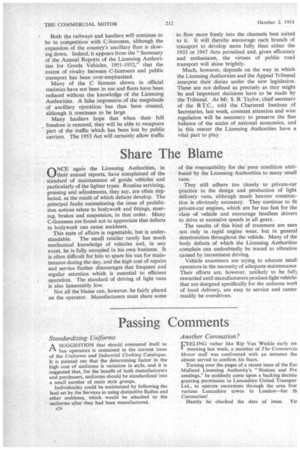Free for All S 0 far, the Transport Act, 1953, 'has
Page 27

Page 28

If you've noticed an error in this article please click here to report it so we can fix it.
had little effect on goods-transport licensing. The Licensing Authorities have adopted a cautious policy. There is no evidence that the objector's burden has become more onerous or that the specific requirement of the 1953 Act that the interests of users shall be placed before all others, has lightened the applicant's onus of proof. There is also no record of attention being paid by the Licensing Authorities to road haulage rates.
"Wait and see" is the guiding principle and is likely, to be followed for some time. Until the sale of road haulage units is well advanced and the future pattern of goods transport by road and rail becomes clearer, the Licensing Authorities must continue to work on the precedents set by the Road and Rail Traffic Act, 1933. When the shape of traffic movements becomes more Sharply defined, however, they may have to adopt an entirely different attitude.
No More Protection Under the 1933 Act, the Licensing Authorities were charged with the duty of protecting the railways against competition from road transport. The 1953 Act removes many of the disabilities under which the railways worked in the past and seeks to _promote free competition between road and rail and internally in road transport.
The railways will no longer need that protection and their objections to applications for licences by hauliers may carry less weight than in the past. In any event, they will, under the 1953 Act, have to prove their objections, instead of making general claims as to the adequacy and suitability of their service, leaving applicants to prove to the contrary.
To that extent, the position of hauliers, vis-à-vis the railways may be improved. The competitive value of the railways' new freedom in fixing rates must not, however, be under-estimated. Certain traffic will, by its nature, always pass by road and some other goods will inevitably go by rail. Between these extremes is a great body of " floating " traffic for which road and rail will be engaged in fierce competition.
Rates will be an important influence in determining the channel into which the traffic flows, but they will not be the sole criterion. Speed, reliability, and safety are qualities that many consignors place above cost, and road transport is able to provide them. Nevertheless, with the reorganization of the railways into more flexible units and the additional powers that have been given to the chief regional managers to meet competition from any source, determined efforts are likely to be made to improve rail services, although the inertia of the staff will first have to be overcome.
B.T.C. -a Powerful Competitor If the British Transport Commission decide to concentrate their road haulage activities on trunk services, co-operation between road and rail in the use of containers and others methods of saving time and reducing breakages may entrench the Commission in the long-distance field, to the virtual exclusion of the free haulier. The new railway classification of goods will pay more regard than formerly to convenience of handling and less to the intrinsic value of the commodity to be carried, and rates for bulk loads are likely to be extremely keen.
If, with their combined resources, the commission are able to establish a virtual monopoly in trunk work, independent operators will be left with short-distance and cross-country haulage and specialized traffic, and the position will not be greatly different from that existing today. The greatest change would be in the extension of crosscountry haulage, brought about partly by the closing of unremunerative branch lines and partly by the repeal of the 25-mile limit.
Whatever shape the picture takes, a standard of operating efficiency and an awareness of costs greater than ever before will be needed in road transport. The 1953 Act is designed to benefit primarily the user and it offers no sympathy to the carrier, road or rail, who cannot withstand keen, fair competition and provide the quality of service required by trade and industry. Both the railways and hauliers will continue to be in competition with C-licensees, although the expansion of the country's ancillary fleet is slowing down. Indeed, it appears from the " Summary of the Annual Reports of the Licensing Authorities for Goods Vehicles, 1951-1952," that the extent of rivalry between C-licensees and public transport has been over-emphasized.
Many of the C licences shown in official statistics have not been in use and fleets have been reduced without the knowledge of the Licensing Authorities. A false impression of the magnitude of ancillary operation has thus been created, although it continues to be large.
Many hauliers hope that when their full freedom is restored, they will be able to recapture part of the traffic which has been lost by public carriers. The 1953 Act will certainly allow traffic to flow more freely into the channels best suited to it. It will thereby encourage each branch of transport to develop more fully than either the 1933 or 1947 Acts permitted and, given efficiency and enthusiasm, the virtues of public road transport will shine brightly.
Much, however, depends on the way in which the Licensing Authorities and the Appeal Tribunal interpret their duties under the new legislation. These are not defined as precisely as they might be and important decisions have to be made by the Tribunal. As Mr. S. B. Taylor, chief secretary of the B.T.C., told the Chartered Institute of Secretaries, last week, constant attention and wise regulation will be necessary to preserve the fine balance of the scales of national economics, and in this matter the Licensing Authorities have a vital part to play.




























































































